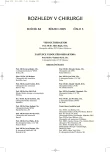-
Medical journals
- Career
Acute Bleeding in the Crohn’s Disease
Authors: R. Kostka
Authors‘ workplace: Chirurgická klinika FNKV a 3. LF UK v Praze, přednosta doc. MUDr. J. Fanta, DrSc.
Published in: Rozhl. Chir., 2005, roč. 84, č. 3, s. 124-127.
Category: Monothematic special - Original
Overview
Acute bleeding is a rare, however a very serious complication of the Crohn‘s disease. Stabilization of the circulation, identification of its source and a consecutive therapeutical strategy remain the principal problem of its management. In addition to classical diagnostic methods, such as colonoscopy, enteroscopy, angiography or radionucleotide scanning, several other methods have emerged recently, e.g. capsule endoscopy, angiography in combination with methylene blue application and angio-CT, all of them enabling to identify the source of the bleeding. Although conservative therapeutical methods have advanced considerably, the bleeding relapse rates remain high. Surgical intervention is essential in unstable patients with massive bleeding and is frequently applied in patients with relapsing bleeding. The surgical treatment results with respect to postoperative mortality rates and to bleeding relapse rates and to relapse rates of the disorder itself, are very good. The haemorrhaging form of the Crohn’s disease is considered a specific phenotype prone to relapses of bleeding, although in other Crohn’s disease patients the massive bleeding does not occur during the course of the disease.
Klíčová slova:
Crohn‘s disease – acute bleeding
Labels
Surgery Orthopaedics Trauma surgery
Article was published inPerspectives in Surgery

2005 Issue 3-
All articles in this issue
- An Inflammatory Aneurysm of the Abdominal Aorta
- Sentinel Node Biopsy in Breast Cancer. Technique and Indication – Standard of Care
- Acute Bleeding in the Crohn’s Disease
- Intraperitoneal Placement of Composite Material – Polyester Mesh with Coat of Polyurethane in Experimental Study
- Impact of Various Types of Artificial Nutrition on Postoperative Complications after Major Surgery of Upper Gastrointestinal Tract
- Implantations of Venous Ports – the Latest Advances
- The Malignant Melanoma Metastasis into the Stomach Corpus
- Transplantation of the Lung Lobe
- Perspectives in Surgery
- Journal archive
- Current issue
- Online only
- About the journal
Most read in this issue- Implantations of Venous Ports – the Latest Advances
- Acute Bleeding in the Crohn’s Disease
- The Malignant Melanoma Metastasis into the Stomach Corpus
- An Inflammatory Aneurysm of the Abdominal Aorta
Login#ADS_BOTTOM_SCRIPTS#Forgotten passwordEnter the email address that you registered with. We will send you instructions on how to set a new password.
- Career

